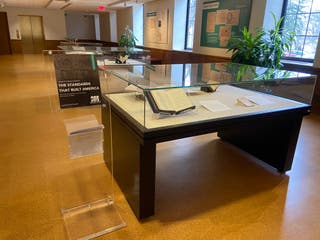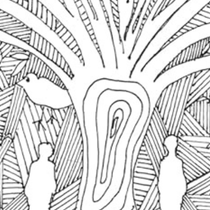History of Science on Display: The Standards that Built America
Standards and specifications refer to published documents from a wide array of organizations written by a consortium of working groups comprised of people who are authorities within their respective fields. These groups work to create a “standard” to promote stability, safety, and interoperability in a wide array of objects – bridges, boilers, road markings, and fire suppression systems. Though typically not legally mandated, these standards are usually adhered to by manufacturers in order to promote safety, accessibility, and ease to the consumer, as well as to avoid litigation. Organizations such as the American National Standards Institute (ANSI) which accredits standards, the American Society of Mechanical Engineers (ASME), the International Organization for Standardization (ISO), and the Institute of Electrical and Electronics Engineers (IEEE) are at the forefront of these innovations.
The Linda Hall Library has over 100,000 standards from over 800 standards organizations. Standards enabled engineers, steelworkers, and construction firms to create the built environment that we live in. These 12 items, drawn from our collection, demonstrate the central role of industrial standards that helped build America.
Items featured in this exhibition:
American Association of State Highway Transportation Officials
Standard Specifications for Highway Bridges and Incidental Structures
Washington, DC, 1931

American Association of State Highway Transportation Officials, Standard Specifications for Highway Bridges and Incidental Structures. Washington, DC, 1931.
The American Association of State Highway Transportation Officials, founded in 1914 as the American Association of State Highway Officials (AASHO), creates standards for the construction and safety of highway and transportation-related materials. In 1921, the AASHO Committee on Bridges and Structures was formed to establish uniformity and safety in bridge construction and published the Standard Specifications for Highway Bridges and Incidental Structures in 1931. This standard, currently in its 17th revision, is still in existence; however, Incidental Structures was removed from the title.
American Association of State Highway Transportation Officials
Manual on Uniform Traffic Control Devices for Streets and Highways
Washington, DC, 1935
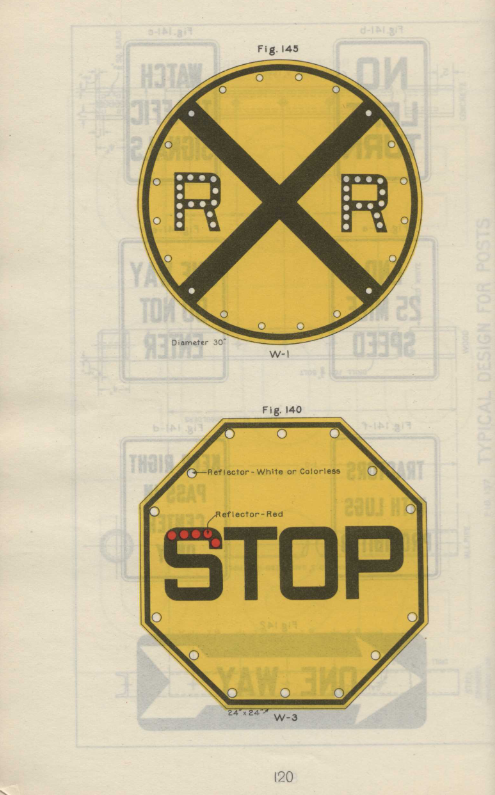
American Association of State Highway Transportation Officials, Manual on Uniform Traffic Control Devices for Streets and Highways. Washington, DC, 1935.
The AASHTO Manual of Uniform Traffic Control Devices has its origin in the 1924 First National Conference on Street and Highway Safety, chaired by then US Secretary of Commerce Herbert Hoover. In this document, recommendations were made for the standardization of colors for traffic control. Recommendations were also made regarding the segregation of pedestrian and automobile traffic, uniformity of braking systems and hand signals, and the establishment of specific traffic courts. Drawing from this conference as well as a follow-up report issued by AASHTO, two manuals were created, the Manual and Specifications for the Manufacture, Display, and Erection of U.S. Standard Road Markers and Signs, designed for use on rural roads, and the Manual on Street Traffic Signs, Signals, and Markings, addressing safety in urban areas. In 1932 a committee was formed to combine the two publications, and as a result, in 1935 this standard was published.
American Society for Testing Materials
ASTM Standards
Philadelphia, 1916

American Society for Testing Materials, ASTM Standards. Philadelphia, 1916.
The proliferation of steel structures in the latter part of the 19th century and the beginning of the 20th century resulted in the need for uniform standards for testing the strength of steel. The newly formed American Society for Testing Materials (ASTM), formed 1898,) took the lead by developing ASTM A-9 Structural Steel for Buildings. This standard became the most widely used standard to determine the use of steel in building construction during this time period, especially in skyscrapers. In 1939, the standard was merged with ASTM A-7, Structural Steel for Bridges, and a new ASTM A-7, Structural Steel for Buildings and Bridges was created. It remained in use until 1960 when it was revised and replaced by ASTM A36, Specification for Carbon Structural Steel, still in use today.
United States of America Standards Institute
USA Standard COBOL
New York, 1968

United States of America Standards Institute, USA Standard COBOL. New York, 1968.
COBOL, or the Common Business Oriented Language, began its development in the late 1950s. Responding to the need for a more efficient computer language for business applications by both government agencies and the public sector, COBOL was formed. COBOL drew heavily from Sperry-Rand’s FLOW-MATIC language developed by Admiral Grace Hopper, which relied on natural language adapted for computer programmers. Hopper also served as technical advisor for COBOL’s development. The language was eventually adopted by banks, insurance companies, and several branches of the federal government and is still in use today over 60 years later, catalyzing the computer-centric age we live in.
In 1962, working groups were formed by both the United States of America Standards International (known today as the American National Standards Institute - ANSI) and the International Organization for Standardization (ISO), to combat inconsistencies within the use and implementation of COBOL. As a result, the first edition of its standardization was published in 1968.
Department of Defense
COBOL: Initial Specifications for a Common Business Oriented Language
Washington, DC, 1960

Department of Defense, COBOL: Initial Specifications for a Common Business Oriented Language. Washington, DC, 1960.
This standard, issued by the Department of Defense, established the foundations of the COBOL standard, and required a programming language for data processing that was computer agnostic, allowing it to be used on almost any brand of computer. COBOL’s adoption and standardization was a direct result of its implementation by the Department of Defense.
In the nearby photo, Admiral Grace Hopper holds a copy of this item, and stands pointing at the magnetic tape reels of a (Universal Automatic Computer) machine.
American National Standards Institute
IEEE Standards for Local Area Networks
New York, 1985
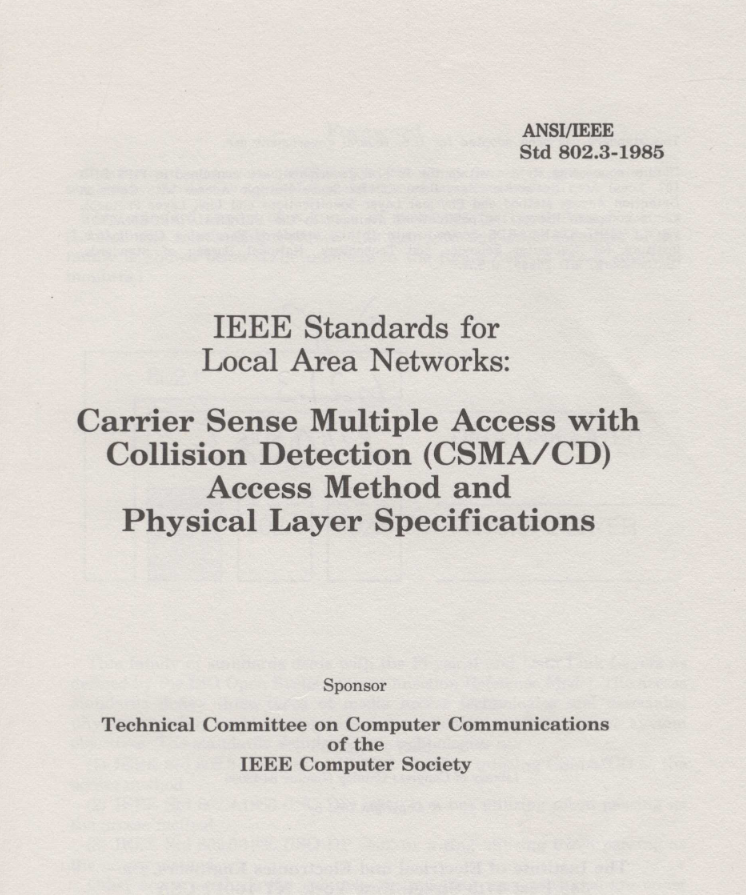
American National Standards Institute, IEEE Standards for Local Area Networks. New York, 1985.
The Institute of Electrical and Electronic Engineers (IEEE), formed in the early 1960s, was the result of a merger between the American Institute of Electrical Engineers and the Institute of Radio Engineers. During the early 1980s, the IEEE 802 committee of standards was formed to standardize and advance computer interconnection utilizing Local Area Networks and ethernet technology. Building and expanding upon the work of Bob Metcalfe of the Xerox corporation, the 802 family of standards was created, allowing for standardized connection and communication between computers over a network. Today, the 802 standards include the specifications for ethernet connections, as well as WiFi. As a marker of its’ importance, IEEE designated the 802 standards as one of "the standards that changed the world," and laid the groundwork for the Internet as we know it today.
American Society of Mechanical Engineers
Safety Code for Cranes, Derricks, and Hoists
New York, 1943

American Society of Mechanical Engineers, Safety Code for Cranes, Derricks, and Hoists. New York, 1943.
American Society of Mechanical Engineers
Safety Code for Jacks
New York, 1943
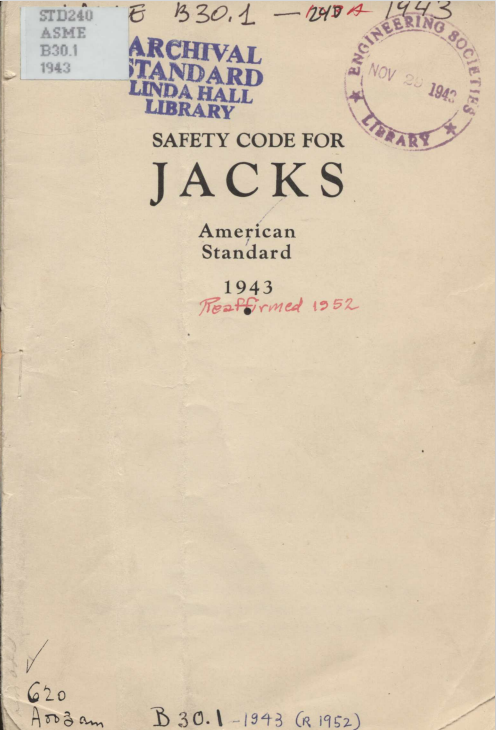
American Society of Mechanical Engineers, Safety Code for Jacks. New York, 1943.
As the rise of industrialization led to increased use of lifting devices such as hoists, jacks, and cranes, a wide range of industry leaders, workers, and federal agencies called for their standardization due to increasingly unsafe working conditions. In 1915, the Sub-Committee on Protection of Industrial Workers was created by the American Society of Mechanical Engineers (ASME). This group’s findings, published in the November 1916 edition of the Journal of the American Society of Mechanical Engineers, called for over three dozen rules and safety upgrades for both construction and operation of lifting devices, as well as safety procedures for Floormen supervising their use and those repairing the equipment. A Sectional Committee was formed to expand on the 1916 findings, eventually leading to the publication of the first two ASME standards for lifting devices used in construction, the Safety Code for Jacks and the Safety Code for Cranes, Derricks, and Hoists.
American Society of Mechanical Engineers
A Safety Code for Elevators
New York, 1921

American Society of Mechanical Engineers, A Safety Code for Elevators. New York, 1921.
As buildings grew taller with standardized strength steel, a need arose for modes of moving building inhabitants safely and efficiently between floors. To help standardize the safety of elevators the Sub-Committee on Protection of Industrial Workers published the Code of Safety Standards for the Construction Operation and Maintenance of Elevators, Dumbwaiters, and Escalators in 1921. This publication currently in its 22nd edition is one of the most heavily used standards in the Linda Hall Library’s collection.
Underwriters’ National Electric Association
National Electrical Code
[New York], 1903
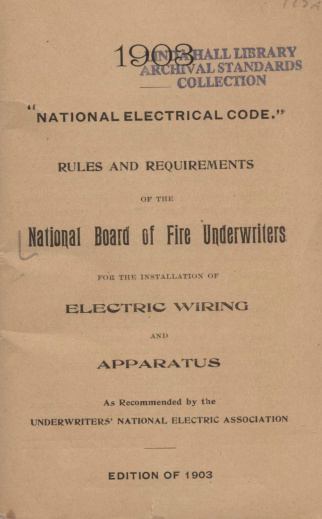
Underwriters’ National Electric Association, National Electrical Code. [New York], 1903.
The National Electrical code was established in an attempt by industry leaders within the fire, electrical, and insurance industries to create a uniform consensus regarding the safety of electrical wiring and installation. The National Electrical Code was officially established by the newly formed National Board of Fire Underwriters in 1897 and adopted by several municipalities and organizations including the American Society of Mechanical Engineers and the American Institute of Electrical Engineers (later the IEEE), using material from five separate codes. The code would be updated roughly every three years. The code is still in publication today published by the National Fire Protection Association, and lives on as NFPA 70.
Society of Automotive Engineers
SAE Handbook
New York, 1913-1916

Society of Automotive Engineers, SAE Handbook. New York, 1913-1916.
Society of Automotive Engineers
Guidelines for Electric Vehicle Safety
Warrendale, 2005
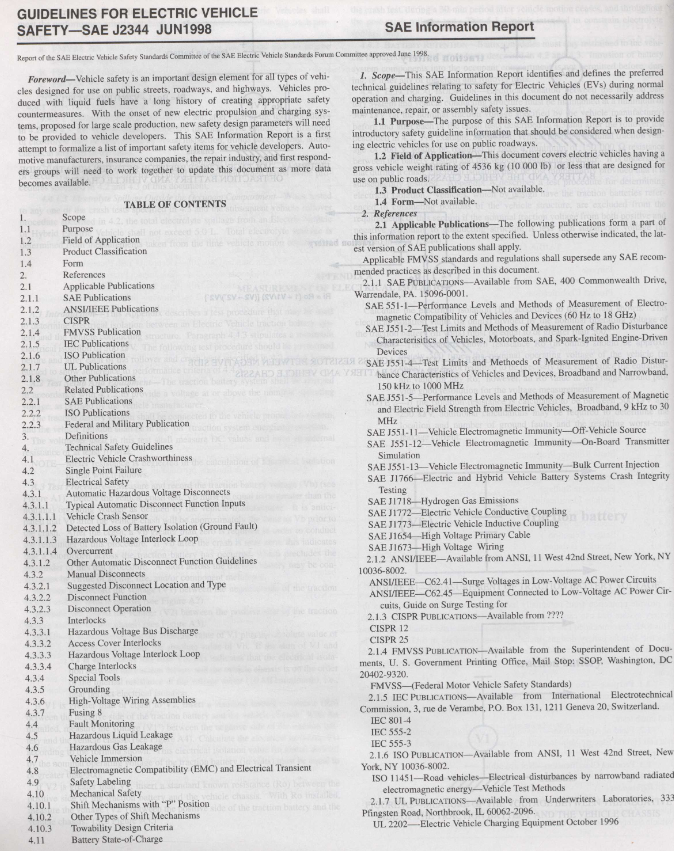
Society of Automotive Engineers, Guidelines for Electric Vehicle Safety. Warrendale, 2005.
Formed in 1905 with Andrew Riker as president and Henry Ford as vice president, and boasting Orville Wright and Thomas Edison as members, the Society of Automotive Engineers (now known as SAE International) was established to help create uniformity within the then-burgeoning automobile industry. Known for its creation of standards for automotive technology, the organization also created its AS (Aerospace Standards), AIR (Aerospace Information Report), and AMS (Aerospace Materials Standards) series of Aerospace Standards. SAE International still creates these aerospace standards, as well as its series of "J" standards designed for ground vehicles found in its SAE Handbook. Included here is one of the earliest standards for spark plugs for the internal combustion engine created in 1915. Juxtaposed is SAE J 2344, the first standard created for safety protocols for the modern era of electric cars.
The Library is open to the public free of charge during regular Library hours, Monday – Friday, 10:00 a.m. – 5:00 p.m.

